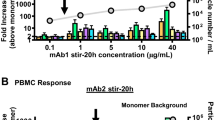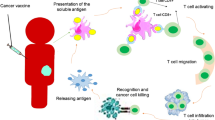Abstract
Here, we reported a cancer nanovaccine based on SiO2 nanoflowers with a special radial pore structure, which greatly enhanced cross-presentation and induced the production of cytotoxic T lymphocyte cells secreting granzymes B and interferon-γ. The antigen ovalbumin was covalently conjugated onto the as-synthesized hierarchical SiO2 nanoflowers, and the adjuvant cytosine-phosphate-guanine was electrostatically adsorbed into their radial pore by simple mixing before use. The nanovaccine exhibited excellent storage stability without antigen release after 27 days of incubation, negligible cytotoxicity to dendritic cells, and a high antigen loading capacity of 430 ± 66 mg·g−1 support. Besides, the nanovaccine could be internalized by dendritic cells via multiple pathways. And the enhancement of antigen/adjuvant uptake and lysosome escape of antigen were observed. Noteworthy, in vitro culture of bone marrow-derived dendritic cells in the presence of nanovaccine proved the activation of dendritic cells and antigen cross-presentation as well as secretion of proinflammatory cytokines. Besides, in vivo study verified the targeting of nanovaccine to draining lymph nodes, the complete suppression of tumor in six out of ten mice, and the triggering of notable tumor growth delay. Overall, the present results indicated that the nanovaccine can be served as a potential therapeutic vaccine to treat cancer.

Similar content being viewed by others
References
Kelly P N. The cancer immunotherapy revolution. Science, 2018, 359(6382): 1344–1345
Sahin U, Türeci Ö. Personalized vaccines for cancer immunotherapy. Science, 2018, 359(6382): 1355–1360
Nam J, Son S, Park K S, Zou W, Shea L D, Moon J J. Cancer nanomedicine for combination cancer immunotherapy. Nature Reviews. Materials, 2019, 4(6): 398–414
Hollingsworth R E, Jansen K. Turning the corner on therapeutic cancer vaccines. NPJ Vaccines, 2019, 4(1): 7
Wculek S K, Cueto F J, Mujal A M, Melero I, Krummel M F, Sancho D. Dendritic cells in cancer immunology and immunotherapy. Nature Reviews. Immunology, 2020, 20(1): 1–18
Hu Z, Ott P A, Wu C J. Towards personalized, tumour-specific, therapeutic vaccines for cancer. Nature Reviews. Immunology, 2017, 18(3): 168–182
Riley R S, June C H, Langer R, Mitchell M J. Delivery technologies for cancer immunotherapy. Nature Reviews. Drug Discovery, 2019, 18(3): 175–196
Huang P, Wang X, Liang X, Yang J, Zhang C, Kong D, Wang W. Nano-, micro-, and macroscale drug delivery systems for cancer immunotherapy. Acta Biomaterialia, 2019, 85: 1–26
Newton J M, Sikora A G, Young S. Chapter 41—Materials-Based Cancer Immunotherapies: Principles of Regenerative Medicine. 3rd ed. Boston: Academic Press, 2019, 715–739
Gause K T, Wheatley A K, Cui J, Yan Y, Kent S J, Caruso F. Immunological principles guiding the rational design of particles for vaccine delivery. ACS Nano, 2017, 11(1): 54–68
Gu L. Tailored silica nanomaterials for immunotherapy. ACS Central Science, 2018, 4(5): 527–529
Giglio V, Varelaaramburu S, Travaglini L, Fiorini F, Seeberger P H, Maggini L, de Cola L. Reshaping silica particles: mesoporous nanodiscs for bimodal delivery and improved cellular uptake. Chemical Engineering Journal, 2018, 340: 148–154
Yang Y, Lu Y, Abbaraju P L, Zhang J, Zhang M, Xiang G, Yu C. Multi-shelled dendritic mesoporous organosilica hollow spheres: roles of composition and architecture in cancer immunotherapy. Angewandte Chemie International Edition, 2017, 56(29): 8446–8450
Abbaraju P L, Meka A K, Song H, Yang Y, Jambhrunkar M, Zhang J, Xu C, Yu M, Yu C. Asymmetric silica nanoparticles with tunable headtail structures enhance hemocompatibility and maturation of immune cells. Journal of the American Chemical Society, 2017, 139(18): 6321–6328
Wang X, Li X, Ito A, Watanabe Y, Sogo Y, Tsuji N M, Ohno T. Stimulation of in vivo antitumor immunity with hollow mesoporous silica nanospheres. Angewandte Chemie International Edition, 2016, 55(5): 1899–1903
Li X, Wang X, Sogo Y, Ohno T, Onuma K, Ito A. Mesoporous silicacalcium phosphate-tuberculin purified protein derivative composites as an effective adjuvant for cancer immunotherapy. Advanced Healthcare Materials, 2013, 2(6): 863–871
Li W A, Lu B Y, Gu L, Choi Y, Kim J, Mooney D J. The effect of surface modification of mesoporous silica micro-rod scaffold on immune cell activation and infiltration. Biomaterials, 2016, 83: 249–256
Wang X, Li X, Yoshiyuki K, Watanabe Y, Sogo Y, Ohno T, Tsuji N M, Ito A. Comprehensive mechanism analysis of mesoporous-silica-nanoparticle-induced cancer immunotherapy. Advanced Healthcare Materials, 2016, 5(10): 1169–1176
An M, Li M, Xi J, Liu H. Silica nanoparticle as a lymph node targeting platform for vaccine delivery. ACS Applied Materials & Interfaces, 2017, 9(28): 23466–23475
Cha B G, Jeong J H, Kim J. Extra-large pore mesoporous silica nanoparticles enabling co-delivery of high amounts of protein antigen and toll-like receptor 9 agonist for enhanced cancer vaccine efficacy. ACS Central Science, 2018, 4(4): 484–492
Moon D S, Lee J K. Tunable synthesis of hierarchical mesoporous silica nanoparticles with radial wrinkle structure. Langmuir, 2012, 28(33): 12341–12347
Du X, Qiao S. Dendritic silica particles with center-radial pore channels: promising platforms for catalysis and biomedical applications. Small, 2015, 11(4): 392–413
Shen Z, Li Y, Wen H, Ren X, Liu J, Yang L. Investigation on the role of surfactants in bubble-algae interaction in flotation harvesting of Chlorella vulgaris. Scientific Reports, 2018, 8(1): 3303
Kuai R, Ochyl L J, Bahjat K S, Schwendeman A, Moon J J. Designer vaccine nanodiscs for personalized cancer immunotherapy. Nature Materials, 2016, 16(4): 489–496
Bowen W S, Svrivastava A K, Batra L, Barsoumian H, Shirwan H. Current challenges for cancer vaccine adjuvant development. Expert Review of Vaccines, 2018, 17(3): 207–215
Warrier V U, Makandar A I, Garg M, Sethi G, Kant R, Pal J K, Yuba E, Gupta R K. Engineering anti-cancer nanovaccine based on antigen cross-presentation. Bioscience Reports, 2019, 39(10): BSR20193220
Casaravilla C, Pittini Á, Rückerl D, Seoane P I, Jenkins S J, MacDonald A S, Ferreira A M, Allen J E, Díaz Á. Unconventional maturation of dendritic cells induced by particles from the laminated layer of larval Echinococcus granulosus. Infection and Immunity, 2014, 82(8): 3164–3176
Yoshida S, Gaeta I, Pacitto R, Krienke L, Alge O, Gregorka B, Swanson J A. Differential signaling during macropinocytosis in response to M-CSF and PMA in macrophages. Frontiers in Physiology, 2015, 6: 8
Kasai H, Inoue K, Imamura K, Yuvienco C, Montclare J K, Yamano S. Efficient siRNA delivery and gene silencing using a lipopolypeptide hybrid vector mediated by a caveolae-mediated and temperature-dependent endocytic pathway. Journal of Nanobiotechnology, 2019, 17(1): 11
El-Sayed A, Harashima H. Endocytosis of gene delivery vectors: from clathrin-dependent to lipid raft-mediated endocytosis. Molecular Therapy, 2013, 21(6): 1118–1130
Kubiak Ossowska K, Jachimska B, Al Qaraghuli M, Mulheran P A. Protein interactions with negatively charged inorganic surfaces. Current Opinion in Colloid & Interface Science, 2019, 41: 104–117
Slowing I, Trewyn B G, Lin V S Y. Effect of surface functionalization of MCM-41-type mesoporous silica nanoparticles on the endocytosis by human cancer cells. Journal of the American Chemical Society, 2006, 128(46): 14792–14793
Latz E, Schoenemeyer A, Visintin A, Fitzgerald K A, Monks B G, Knetter C F, Lien E, Nilsen N J, Espevik T, Golenbock D T. TLR9 signals after translocating from the ER to CpG DNA in the lysosome. Nature Immunology, 2004, 5(2): 190–198
Hjortø G M, Larsen O, Steen A, Daugvilaite V, Berg C, Fares S, Hansen M, Ali S, Rosenkilde M M. Differential CCR7 targeting in dendritic cells by three naturally occurring CC-chemokines. Frontiers in Immunology, 2016, 7: 568
Gerlach C, Moseman E A, Loughhead S M, Alvarez D, Zwijnenburg A J, Waanders L, Garg R, de la Torre J C, von Andrian U H. The chemokine receptor CX3CR1 defines three antigen-experienced CD8+ T cell subsets with distinct roles in immune surveillance and homeostasis. Immunity, 2016, 45(6): 1270–1284
Lutz M B, Schuler G. Immature, semi-mature and fully mature dendritic cells: Which signals induce tolerance or immunity? Trends in Immunology, 2002, 23(9): 445–449
Tugues S, Burkhard S H, Ohs I, Vrohlings M, Nussbaum K, Vom Berg J, Kulig P, Becher B. New insights into IL-12-mediated tumor suppression. Cell Death and Differentiation, 2015, 22(2): 237–246
Kaplanski G, Marin V, Montero Julian F, Mantovani A, Farnarier C. IL-6: a regulator of the transition from neutrophil to monocyte recruitment during inflammation. Trends in Immunology, 2003, 24(1): 25–29
Sixt M, Kanazawa N, Selg M, Samson T, Roos G, Reinhardt D P, Pabst R, Lutz M B, Sorokin L. The conduit system transports soluble antigens from the afferent lymph to resident dendritic cells in the T cell area of the lymph node. Immunity, 2005, 22(1): 19–29
Sallusto F, Geginat J, Lanzavecchia A. Central memory and effector memory T cell subsets: function, generation, and maintenance. Annual Review of Immunology, 2004, 22(1): 745–763
Nimmerjahn F, Bruhns P, Horiuchi K, Ravetch J V. FcγRIV: a novel FcR with distinct IgG subclass specificity. Immunity, 2005, 23(1): 41–51
Acknowledgements
The authors thank for the National Natural Science Foundation of China (Grant No. 81972899), Natural Science Foundation of Tianjin City (Grant No. 18JCQNJC14500), CAMS Innovation Fund for Medical Sciences (Grant No. 2017-I2M-3-022), Specific Program for High-Tech Leader&Team of Tianjin Government, Tianjin innovation and promotion plan key innovation team of immunoreactive biomaterials. The authors declare that they have no conflict of interest.
Author information
Authors and Affiliations
Corresponding authors
Electronic Supplementary Material
Rights and permissions
About this article
Cite this article
Zhang, C., Dong, Y., Gao, J. et al. Radial porous SiO2 nanoflowers potentiate the effect of antigen/adjuvant in antitumor immunotherapy. Front. Chem. Sci. Eng. 15, 1296–1311 (2021). https://doi.org/10.1007/s11705-020-2034-6
Received:
Accepted:
Published:
Issue Date:
DOI: https://doi.org/10.1007/s11705-020-2034-6




